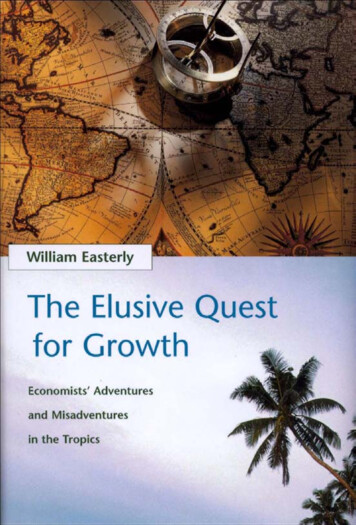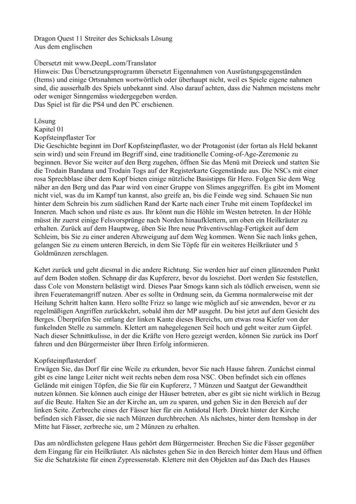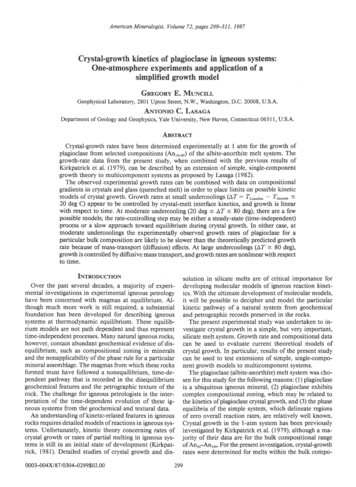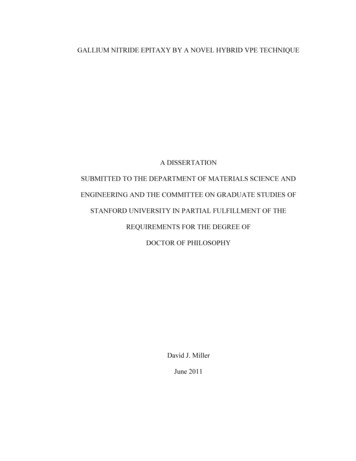
Transcription
The Elusive Quest forGrowthEconomists’ Adventuresand Misadventures in theTropicsWilliam EasterlyThe MIT PressCambridge, MassachusettsLondon, England
0 2001 Massachusetts Institute of TechnologyAll rights reserved. No part of this book may be reproduced in any form by anyelectronic or mechanical means (including photocopying, recording, or informationstorage and retrieval) without permission in writing from the publisher.Lyrics from ”God Bless the Child,” Arthur Herzog, Jr., Billie Holiday 0 1941, EdwardB. Marks Music Company.Copyright renewed. Used by permission. All rightsreserved.This book was set in Palatino by Asco Typesetters, Hong Kong, in ’3B2’Printed and bound in the United States of America.Library of Congress Cataloging-in-Publication DataEasterly, William.The elusive quest for growth :economists’ adventures and misadventures in thetropics /William Easterly.p. cm.Includes bibliographical references and index.ISBN 0-262-05065-X (hc. :alk. paper)1.Poor-Developing countries. 2. Poverty-Developing countries. 3. Developingcountries-Economic policy. I. Title.HC59.72.P6 E172001338.9’009172’4-dc2100-
To Debbie, Rachel, Caleb, and Grace
This Page Intentionally Left Blank
ContentsAcknowledgments ixPrologue: The Quest xiIWhy Growth Matters1To Help the Poor15Intermezzo: In Search of a RiverI1 Panaceas That Failed2Aid for Investment2125Zntermezzo: Parmila345Solow’s Surprise: Investment Is Not the Key to GrowthIntermezzo: DryCornstalks4Educated for What?707185Intermezzo: WithoutaRefuge5Cash for Condoms?87Zntermezzo: TombPaintings61699The LoansThatWere, the Growth ThatWasn’tZntermezzo: Leila’sStory12110347
ardHouse138I11 rns:Leaks,Matches,andTrapsIntermezzo:War and Intermezzo: Accident in Jamaica10 UnderanEvilStar19321511 GovernmentsCanKillGrowth217Intermezzo: Florence and Veronica12 CorruptionandGrowth240241Intermezzo: Discrimination in Palanpur13 PolarizedPeoples171195Intermezzo:Favela Life255Intermezzo: Violent for Centuries28214 Conclusion:TheViewfromLahoreNotes 293References and FurtherReadingIndex 335145285313253
AcknowledgmentsI am very grateful to RossLevine and Lant Pritchett, who madecomments on various drafts and provided manyinsights throughnumerous discussions of growth. I amalso grateful for comments tomy editors at MIT Press, five anonymous referees, Albert0 Alesina,RezaBaqir,Roberta Gatti, Ricardo Hausmann, Charles Kenny,MichaelKremer, Susan Rabiner, Sergio Rebelo, Sergio Schmukler,Michael Woolcock, to my coauthors of various studies I use here,from whom I have learned much, including the late Michael Bruno,Shanta Devarajan, David Dollar, Allan Drazen, Stanley Fischer, Roumeen Islam, Robert King, Aart Kraay, Paolo Mauro, Peter Montiel,Howard Pack, Jo Ritzen, Klaus Schmidt-Hebbel, Lawrence Summers,Joseph Stiglitz, Holger Wolf, and David Yuravlivker, to the organizers of the very educational National Bureau of Economic Researchmeetings on growth, including RobertBarro, Charles Jones, PaulRomer, Jeffrey Sachs, and Alwyn Young, and to the many participants in seminars, classes at Georgetown and Johns HopkinsSchoolof Advanced International Studies, and training courses whereIhave presented parts of the draft of this book. I alone am responsiblefor views expressed here.
This Page Intentionally Left Blank
Prologue: The QuestThe theme of the quest is ancient. In many versions, it is the searchfor a precious object with magical properties:theGolden Fleece,the Holy Grail, the Elixir of Life. The precious object in most of thestories either remains elusive or is a disappointmentwhen found.Jason got the Golden Fleece with the help of Medea, who betrayedher own father, but Jason and Medea’s subsequent marriage wasratherdysfunctional.JasonbetrayedMedea inturn for anotherprincess; she worked out her disappointment by killing Jason’s newbride and her own children.Fifty years ago, in the aftermath of World War 11, we economistsbegan our own audacious quest: todiscover the means by whichpoor countries in the tropics couldbecome rich like the rich countriesin Europe and North America. Observing the sufferings of the poorand the comforts of the rich motivated us on our quest. If our ambitious quest were successful, it would be one of humankind’s greatintellectual triumphs.Like the ancient questors, we economists have tried to find theprecious object, the key that would enable the poor tropics tobecome rich. We thought we had found theelixir many different times.The precious objects we offered ranged from foreign aid to investment inmachines, from fostering education tocontrolling ms to givingdebtrelief conditional on reforms. None has delivered as promised.The poor countries that we treated with these remedies failed toachieve the growth we expected. The region we treated most intensively, sub-Saharan Africa, failed to grow at all. Latin America andthe Middle East grew for awhile, but then spiraled into a growthcrash in the 1980s and 1990s. South Asia, another recipient of intensive attention from economists, has suffered from erratic growth that
xiiPrologue: The Questhas still left it the home to a huge proportion of the world’s poor.And most recently, East Asia, the shining success we celebrated overand over, went into its own growth crash (from which some,but notall, East Asian nations are now recovering). Outside the tropics, wetried applying some of the tropical remedies to the ex-communistcountries-with very disappointing results.Just as various claims to havefound the elixir of life provedgroundless, we economists have too often peddled formulas thatviolated the basic principle of economics. The problem was not thefailure of economics, but the failure to apply the principles of economics in practical policy work. What is the basic principle of economics? As a wise elder once told me, ”People do whatthey get paidto do; what they don’t get paid to do, they don’t do.’’ A wonderfulbook by Steven Landsburg, The Armchair Economist, distills the principle more concisely: ”People respond to incentives; all the rest iscommentary.”Economists have doneof lot of research over the past two decadesonhow economic growthresponds to incentives. This workhasvariously detailed how private businesses and individuals respondto incentives, how government officials respond to incentives, andeven how aid donors respond to incentives. This research shows thata society’s economic growth does not always pay off at the individual level for government officials, aid donors, and privatebusinessesand households. Incentives often lead them in other, unproductive,directions. This research makes clear how unfortunately misguided,with the benefit of hindsight, were the past panaceas-includingsome still in force today-for economic growth in the tropics.To find their wayfrompovertyto riches, weneedremindingthat people do what they get paid to do. If we do the hard workof ensuring that the trinity of First World aid donors, Third Worldgovernments, and ordinary Third World citizens have the right incentives, development will happen. If they don’t, it won’t. We willsee that the trinity often did not have the right incentives, followingformulas that violated the basic principle of economics, and so theexpected growth did not happen.This is a sad story, but it can be a hopeful one. We now have statistical evidence to back up theories of how the panaceas failed andhow incentive-based policies can work. Incentives can change andstart countries on the road to prosperity.It won’t be easy. Incentivesare notthemselves a facile panacea. We will see how the interlocking
Prologue: The Quest.x111incentives of aid donors, governments, and citizens form a complicated web that is not easily untangled.Moreover, there is already widespread disappointment that thequest has not been moresuccessful. Protesters from Seattle to Praguecall for abandoning the quest altogether. That is not acceptable. Aslong as there are poor nations suffering from pestilence, oppression,and hunger, asI describe in the first part of the book, and as long ashuman intellectual efforts can devise ways to make them richer, thequest must go on.Four notes before I begin. First, what I say hereis my ownopinionand not that of my employer, the World Bank. Occasionally I ameven critical of what my employer has done in the past. One thingIadmire about the WorldBank is that it encouragesgadflies like me toexercise intellectual freedom and doesn’t stifle internal debate onWorld Bank policies.Second, I am not going to say anything about the environment. Itried to say something about the environment in early drafts of thisbook, but found I didn’t have anything usefulto say. Thereis abig issue about how growthaffects the environment, but that’s adifferent book. Most economists believe that any negative effects ofgrowth on the environment can be alleviated with wise environmental policies, like making polluters bear the costs of their deleterious effects on humanwelfare, and so we don’t actually have to stopeconomic growth to preserve the environment.This is a good thing,becausestoppinggrowthwouldbeverybadnewsfor thepooreverywhere, as I discuss in the first chapter.Third, I am not trying to do a general survey of all of economists’research on growth. This research has exploded in the past decadeand a half, following the seminal work of Stanford Business Schoolprofessor Paul Romer and, later, the inspirational workof NobelPrize winner Robert Lucas. There is not yet a scholarly consensus onsome issues, although I think the evidence is strongon others. I try tofollow the thread of work that specifically relates to the efforts ofeconomists to figure out how to make poortropical countries rich.Fourth, I am going to insert snapshotsof daily life in the ThirdWorld, ”intermezzos,” between chapters to remind us that behindthe quest for growth are thesufferings and joys of real people, and itis for them we go on the questfor growth.
This Page Intentionally Left Blank
IWhy Growth Matters
This Page Intentionally Left Blank
As I pursue my career as a self-anointed expert on poor countries,the differences in thelives of the poor and therich supply motivation.We experts don’t care about rising gross domestic productfor itsown sake. We care because it betters the lotof the poor and reducesthe proportionof people who are poor.We care because richer peoplecan eat more and buy more medicines for their babies. In this part,I review the evidence on growth andrelief from poverty.
This Page Intentionally Left Blank
1To Help the PoorWhen I see another child eating, I watch him, andI think I'm going to die of hungeu.-Aif he doesn'tgive me somethingten-year-old child in Gabon, 1997I am in Lahore, a city of 6 million people in Pakistan, on a WorldBank trip asI write this chapter.Last weekend I went with a guide tothe village of Gulvera, not far outside Lahore. We entered the villageon an impossibly narrow paved road, which the driver drove at topspeed except on the frequent occasions that cattle were crossing theroad. We continued as the road turned into a dirt track, where therewas barely enough space between thevillage houses for the car.Then the road seemed to dead-end. But although I could not detectany road, the guide pointed out to the driver how he could make asharp right across an open field, then regain a sort of a road-flatdirt anyway. I hated to think what would happen to these dirt roadsin rainy season.The "road" brought us to the community center for the village,where a numberof young and oldmen were hanging out (no women,on which more in a moment).The village smelled of manure. The menwere expecting us and were extremely hospitable, welcoming us into the brick-and-mortar community center, everyone grasping eachof our right hands with their two hands and seating us on somerattan benches. They provided pillows for us to lean on or withwhich to otherwise make ourselvescomfortable. They served us adrink of lassi, a sort of yogurt-milk mixture. The lassi pitcher wasthickly covered with flies, but I drank my lassi anyway.The men said that during the week, they worked all day in thefields, then came to the community center in the evenings to play
6Chapter 1cards and talk. The women couldn’t come, they said, because theystill had work to do in the evenings. Flocks of flies hummed everywhere, and some of the men had open sores on their legs.There wasone youngish but dignified man nicknamed Deenu to whom everyone seemed to defer. Most of the men were barefoot, wearing longdusty robes.A crowd of children hung around the entrance watchingus-only boys, no girls.I asked Deenu what the main problems of Gulvera village were.Deenu said they were glad to have gotten electricity just six monthsbefore. Imagine getting electricity after generations spent in darkness. They were glad to have a boys’ elementary school. However,they still lacked many things: agirls’ elementary school, a doctor,drainage or sewerage (everything was dumped into a pool of rancid ns,pavedroads. The poorsanitaryconditionsandlack of access tomedical care in villages like Gulvera may help explain why a hundred out of every thousand babies die before their first birthday inPakistan.I asked Deenu if we could see a house. He walked with usover tohis brother’s house. It was an adobe-walled dirt-floor compound,which had two small rooms where they lived, stallsfor the cattle, anoutside dung-fired oven built into wall,apiles of cattle dung stackedup to dry, and a hand pump hooked up to a well. Children wereeverywhere, including a few girls finally, staring curiously at us.Deenu said his brother had seven children. Deenu himself had sixbrothers and seven sisters. The brothers all lived in the village; thesisters had married into other villages.The women in the householdhung back near the two small rooms.We were not introduced tothem.Women’s rightshavenotyet come toruralPakistan,afactreflected in some grim statistics: there are108 men for every 100women in Pakistan. In rich countries, women slightly outnumbermen because of their greater longevity. In Pakistan, there are whatNobel Prize winner AmartyaSen called “missing women,” reflectingsome combination of discrimination against girls in nutrition, medical care, or evenfemale infanticide. Oppressionof women sometimestakes an even more violent turn. There was a story in the Lahorenewspaper of a brother who hadkilled his sister to preserve thefamily honor; he had suspected her of an illicit affair.
To Help the Poor7Violence in the countryside is widespread in Pakistan, despite thepeaceful appearance of Gulvera. Another story in the Lahore paperdescribed a village feud in whichone family killed seven membersofanother family. Bandits and kidnappers prey on travelers in partsofthe countryside in Pakistan.We walked back to the community center, passing a groupof boysplaying a game, where they threw four walnuts on the ground andthen tried to hit oneof the walnuts with another one. Deenu asked usif we would like to stay for lunch, but we politely declined(I didn‘twant to take any of their scarce food), said our good-byes, and droveaway. Oneof the villagers rode away withus, just to havean adventure. He told us that they had arranged for two cooks to prepare ourlunch. I felt bad about having declined the lunch invitation.We drove across the fields to where four brothers had groupedtheir compounds into a sort of a village and went through the sameroutine: the men greeting us warmly with two hands and seatingus on rattan benches outside. No women were to be seen. The children were even more numerous and uninhibited than in Gulvera;they were mostly boys but this time also a few girls. They crowdedaround us watching everything we did, frequently breaking intolaughter at some unknown faux pasby one of us. The men served ussome very good milky sweet tea. I saw a woman peeking out frominside the house,but when I looked in her direction, she pulledbackout of sight.We walked into one of the brothers’ compounds. Many womenstoodatthedoorsintotheirrooms, hanging back butwatchingus. The men showed us a churn that they used to make butter andyogurt. One of the men tried to show us howto use it, but he himselfdidn’t know; this was woman’s work.The children nearly passed outfrom laughing. The men brought us some butter to taste. They saidthey melted the butter to make ghee-clarified butter-which wasan important ingredient in theircooking. They said if you ate alot ofghee, it made you stronger. Then they gave us some ghee to taste.Most of their food seemed to consist of dairy products.I asked what problems they faced. They had gotten electricity justone month before. They otherwise had the same unfulfilled needsas Gulvera: no telephone, no running water, no doctor, no sewerage,no roads. This was only a kilometer off the main road just outsideLahore, so we weren’t in the middle of nowhere. They were poor,
8Chapter 1but these were relatively well-off villagers compared to more remotevillages in Pakistan. The road leading to their minivillage was a halflane track constructed of bricks that they had made themselves.The majority of people in Pakistan are poor:85 percent live on lessthan two dollars a day and31 percent live in extreme poverty at lessthan onedollar a day.The majority of the world’s people live in poornations like Pakistan, where people live in isolated poverty evenclose to a major city. The majority of the world’s people live in poornations where women are oppressed, far too many babies die, andfar too many people don’t have enough to eat. We care about economic growth for the poor nations because it makes the lives of poorpeople like those in Gulvera better. Economic growth frees the poorfrom hunger and disease. Economy-wide GDP growth per capitatranslates into rising incomes for the poorest of the poor, lifting themout of poverty.The Deaths of the InnocentsThe typical rate of infant mortality in the richest fifth of countries is 4out of every 1,000 births; in the poorest fifth of countries, it is 200 outof every 1,000 births. Parents in the poorest countries are fifty timesmore likely than in the richest countries to know grief rather thanjoyfrom the birth of a child. Researchers have found that a 10 percentdecrease in income is associated with about a6 percent higher infantmortality rate.1The higher rates of babies dying in the poorest countries reflect inpart the higher rates of communicable and often easily preventablediseases such as tuberculosis, syphillis, diarrhea, polio, measles, tetanus, meningitis, hepatitis, sleeping sickness, schistosomiasis, riverblindness, leprosy, trachoma, intestinal worms, and lower respiratory infections.2 At low incomes, disease is more dangerous becauseof lower medical knowledge, lower nutrition,and lower access tomedical care.Two million children die every year of dehydration from diarrhea.3 Another 2 million children die annually from pertussis, polio,diphtheria, tetanus, and measle . Three million children dieannuallyfrom bacterial pneumonia.Overcrowding of housing and indoor woodor cigarette smoke makepneumonia among children more likely. Malnourished children are
To Help the Poor9also more likely to develop pneumonia than well-fed children5 Bacterial pneumonia can be cured bya five-day course of antibiotics,like cotrimoxazole, that costs about twenty-five cents6Between 170 million and 400 million children annually areinfectedwithintestinalparasiteslike hookwormandroundworm,whichimpair cognition and cause anemia and failure to t h r i e . Deficiency of iodine causes goiters-swelling of the thyroid glandat the throat-and lowered mental capacity. About 120,000 childrenborn each year suffer from mental retardation andphysical paralysiscaused by iodine deficiency. About 10 percent of the world’s population, adults and children both, suffer from goiter.8Vitamin A deficiency causes blindness in about half a million children and contributes to the deaths of about 8 million children eachyear.9 It is not independent of the other diseases discussed here; itmakes death more likely from diarrhea, measles, and pneumonia.Medicines that would alleviate these diseases are sometimes surprisingly inexpensive, a fact that UNICEF often uses to dramatizethe depths of poverty of these suffering people. Oral rehydrationtherapy, at a cost of less than ten cents for each dose, can alleviatedehydration.l0 Vaccination against pertussis, polio, diphtheria, measles, and tetanus costs about fifteen dollars per child.ll Vitamin Acan be added to diets through processing of salt or sugar or administered directly through vitamin A capsules every six months. Vitamin A capsules cost about two cents each.12 Iodizing salt supplies,which costs about five cents per affected person per year, alleviatesiodine deficiency.13 Intestinal parasites can be cured with inexpensive drugs like albendazole and praziq ante1.l Wealthier and HealthierLant Pritchett, from Harvard’s Kennedy School of Government, andLarry Summers, the former US. secretary of the treasury, found astrong association between economic growth and changes in infantmortality. They pointed out that a third factor that was unchangingover time for each country,like ”culture” or ”institutions,” could notbe explainingthesimultaneouschangeinincome and change ininfant mortality. Going further, they argued that the rise in incomewas causing the fall in mortality rather than the other way around.They used a statistical argument that we will see more of later in
10Chapter 1this book. They observed some income increases that were probablyunrelated to mortality, like income increases due to rises in a country’s export prices. They traced through the effect of such an incomeincrease, finding that it still did result in afall in infant mortality. Ifan income increase that has nothing to do with mortality changes isstill associated with afall in mortality, this suggests thatincomeincreases are causing reduced mortality.Pritchett and Summers’s findings, if we can take them literally,imply huge effects of income growth on the death of children. Thedeaths of about half a million children in 1990 would have beenaverted if Africa’s growthinthe1980s had been 1.5 percentagepoints higher.The Poorest of the PoorThe statisticspresented so fararenationalaverages.Behind theaverages of even the poorest nation, there is still regional variation.Mali is one of the poorest nations on earth.The countryside along theNiger River around the city of Tombouctou (Timbuktu) is oneof thepoorest regions in Mali and thus one of the poorest places on earth.At the time of a survey in1987, over a thirdof the children under agefive had had diarrhea in the preceding two weeks.Very few of themwere on simple and cheap oral rehydration therapy. None had beenvaccinated for diphtheria, pertussis, or typhoid. Forty-one percentofchildren born do not live to the ageof five, three times the mortalityrate in the capital of Bamako and one of the highest child mortalityrates ever r e 0 r d e d . l As in Tomboctou, there are some regions or peoples at the verybottom of the economic pyramid, despised even by other poor. ”InEgypt they were madfoun-the buried or buried alive; in Ghana,ohiabrubro-the miserably poor, with no work, sick with no one tocare for them; in Indonesia, endek araktadak; in Brazil, miseraveis-the deprived;in Russia, bomzhi-the homeless; inBangladeshghrinogorib-thedespised/hated poor.” In Zambia thebalandanasana or bapina were described in these terms:”Lack food, eat once ortwice; poor hygiene, flies fall over them, cannot afford school andhealth costs, lead miserable lives, poor dirty clothing, poor sanitation, access to water, look like madepeople,liveonvegetablesand sweet potatoes.” In Malawi, the bottom poor were osaukitsitsa,”mainly households headed by the aged, thesick, disabled, orphans
To Help the Poor11andwidows.” Some were described as onyentchera, “thestuntedpoor, with thin bodies, short stature and thin hairs, bodies that didnot shine even after bathing, and who experience frequent illnessesand a severe lack of food.”16EatingHigh mortality in the poorest countries also reflects the continuingproblem of hunger. Daily calorie intake is one-third lower in thepoorest fifth of countries than in the richest fifth.A quarter of the poorest countries had famines in the past threedecades; none of the richest countries faced a famine. In the poorestnations like Burundi, Madagascar, and Uganda, nearly half of allchildren under the age of three areabnormallyshortbecauseofnutritional deficiency.17An Indian family housed in a thatched hut seldom ”could havetwo square meals a day.The lunch would be finished munchingsome sugarcane. Once in a while they would taste ’sattu’ (made offlour), pulses [dried beans], potatoes etc. but for occasions only.”lsIn Malawi, the poorest families “stay without food for 2-3 days oreven the whole week .and may simply cook vegetables for a meal. some households literally eat bitter maize bran (gaga/deya owawa)and gmelina sawdust mixed with alittle maize flour especially duringthe hunger monthsof January andFebruary.”19Oppression of the PoorPoor societies sometimes have some form of debt bondage. To takeone example, observers of India report ”a vicious cycle of indebtedness in which a debtor may work in a moneylender’s house as aservant, on his farm as a laborer. .The debt may accumulate substantially due to high interest rates, absence due to illness, and expenses incurred for food or accommodations.”20Ethnic minorities are particularly prone to oppression. In Pakistan in 1993, the Bengali community of Rehmanabad in Karachi “hadbeen subject to evictions and bulldozing, and on returning to thesettlement and constructing temporary housing of reeds and sacks,have faced on-going harassment by land speculators, the police andpolitical movements.”21
12Chapter 1Poor children are particularly vulnerable to oppression. Forty-twopercent of children aged ten to fourteen are workers in the poorestcountries. Less than 2 percent of children aged ten to fourteen areworkers inthe richest countries. Although most countries have lawsforbidding child labor, the U.S. StateDepartment classifies manycountries as not enforcing these laws. Eighty-eight percent of thepoorest countries are in this no-enforcement category; none of therichest countries is.22For example, we have this story of Pachawakin western Orissa state in India: ”Pachawak dropped out of class 3when one day his teacher caned him severely. Since then he hasbeen working aschild labor with a numberof rich households. Pachawak’s father owns 1.5 acres of land and works as a laborer. Hisyounger brother of ll-years-old also became a bonded laborer whenthe family had to take a loan for the marriage of the eldest son. Thesystem is closely linked to credit, as many families take loans fromlandlords, who inlieu of that obligationkeep the childrenas ’kuthia.’Pachawak worked as a cattle grazer from 6 A.M. to 6 P.M. and gotpaid two to four sacks of paddy a year, two meals a day, and onelungi [wrap-around clothing].”One particularly unsavory kind of child labor is prostitution. InBenin, for example, “the girls have no choice but to prostitute themselves, starting at 14, even at 12. They do it for 50 francs, or just fordinner.“23Another occupation in which children work in poor countries isparticularly dangerous: war. As many as 200,000 child soldiers fromthe ages of six to sixteen fought wars in poor countries like Myanmar, Angola, Somalia, Liberia, Uganda, and M o z a m b i q e . Women are also vulnerable to oppression in poor countries.Overfour-fifths of the richest fifth of countries have social and economicequality for women most of the time, according to the W o d d HumanRights Guide by Charles Humana. None of the poorest fifth of countries has social and economic equality for women.2s In Cameroon,”Women in some regions require a husband’s, father’s, or brother’spermission to go out. In addition, awoman’s husband or brother hasaccess to her bank accounts, but not vice versa.” A 1997 survey inJamaica found that ”in all communities, wife-beating was perceivedas a common experience in daily life.” In Georgia in the Caucasus,”women confessed that frequent household arguments resultedinbeing beaten.” In Uganda in 1998, when women were asked, “What
To Help the Poor13kind of work do men in your area do?” they laughed and said,”Eatand sleep then wake up and go drinking again.”26Growth and PovertyMy World Bank colleagues Martin Ravallion and ShaohuaChencollected data on spells of economic growth and changes in povertycovering the years 1981 to 1999. They get their data from nationalsurveys of household income or expenditure. They require that themethodology of the survey be unchanged over the period that theyare examining so as to exclude spurious changes due to changingdefinitions. They found 154 periods of changein 65 developingcountries with data that met this requirement.Ravallion and Chen defined poverty as an absolute concept withineach country: the poor were defined as the part of the populationthat had incomes below 1a day atthe beginningof each period theywere examining. Ravallion and Chen keep this povertyline fixedwithin each country during the periodthey analyze. So the questionwas, Howdid aggregate economic growthchangetheshareofpeople below this povertyline?The answer was quite clear: fast growth went with fast povertyreduction, and overall economic contractionwent with increasedpoverty. Here I summarize Ravallion and Chen’s data by dividingthe number of episodes into four equall
viii Contents 7 Forgive Us Our Debts 123 Intermezzo: Cardboard House 138 I11 People Respond to Incentives 141 8 Tales of Increasing Returns: Leaks, Matches, and Traps 145 Intermezzo: War and Memory 170 9 Creative Destruction: The Power of Technology 171 Intermez










